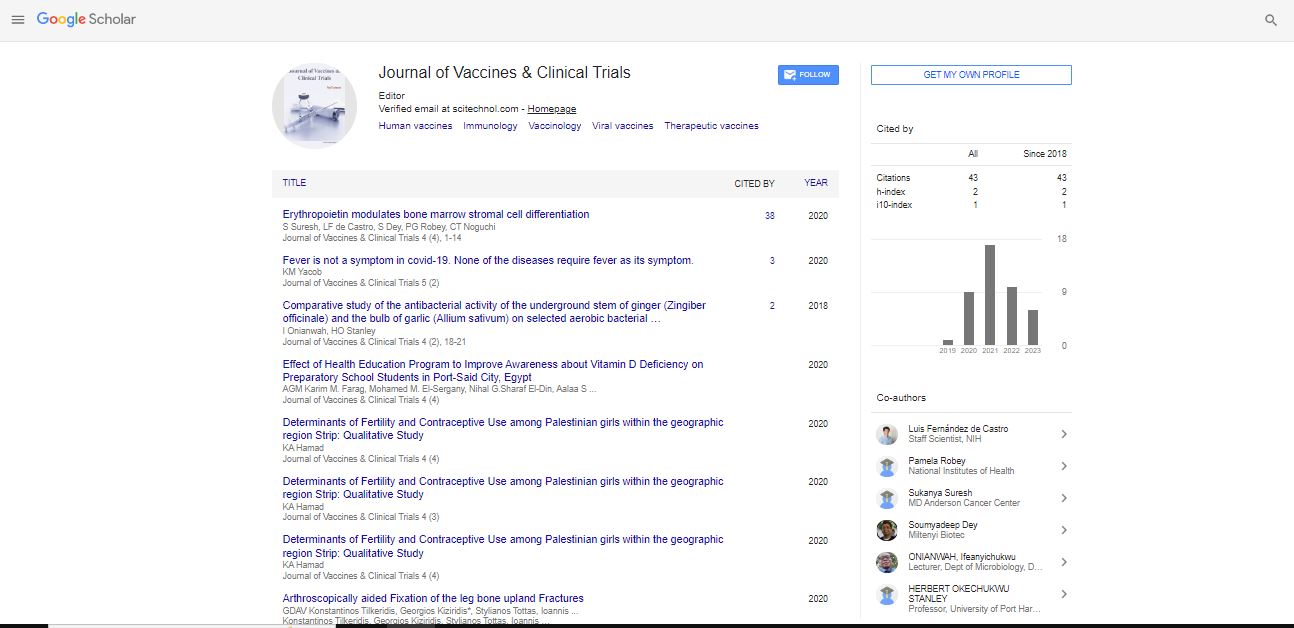Opinion Article, Jou Of Vac Cli Tr Vol: 7 Issue: 2
The Mechanisms of Vaccination: Exploring Different Formulations by the Central Drugs Standard Control Organization (CDSCO)
Mallah Fleszar*
1Department of Health, Behavior and Society, Johns Hopkins Bloomberg School of Public Health, Baltimore, USA
*Corresponding Author: Mallah Fleszar,
Department of Health, Behavior and
Society, Johns Hopkins Bloomberg School of Public Health, Baltimore, USA
E-mail: Fleszarllah81@hotmail.com
Received date: 29 May, 2023, Manuscript No. JVCT-23-102752;
Editor assigned date: 31 May, 2023, PreQC No. JVCT-23-102752(PQ);
Reviewed date: 14 June, 2023, QCNo JVCT-23-102752;
Revised date: 21 June, 2023, Manuscript No. JVCT-23-102752(R);
Published date: 28 June, 2023, DOI: 10.4172/JVCT.100074
Citation: Fleszar M (2023) The Mechanisms of Vaccination: Exploring Different Formulations by the Central Drugs Standard Control Organization (CDSCO). Jou of Vac Cli Tr 7:2.
Description
Vaccination is an important strategy in preventing and controlling infectious diseases. The Central Drugs Standard Control Organization (CDSCO) plays a vital role in evaluating and approving different formulations of vaccines to ensure their safety and efficacy. This study aims to provide an overview of how vaccination works and discuss various formulations of vaccines evaluated by the CDSCO. The mechanisms of action and the impact of these formulations on immune responses will be explored. Understanding the diverse formulations of vaccines will aid in improving global vaccination strategies and enhancing public health.
Vaccination is a powerful tool in preventing the spread of infectious diseases and protecting public health. The CDSCO, India's regulatory authority for drugs and vaccines, assesses the safety, quality, and efficacy of different vaccine formulations before they are approved for use. This study aims to elucidate the underlying mechanisms of vaccination and highlight the various formulations evaluated by the CDSCO, providing valuable insights into their effectiveness in eliciting immune responses.
Mechanisms of vaccination
Vaccination stimulates the immune system to recognize and mount a defense against specific pathogens. Different vaccine formulations utilize various mechanisms to induce immune responses. Live attenuated vaccines contain weakened forms of the pathogen, which replicate in the body and elicit a robust immune response. Inactivated or killed vaccines use inactivated pathogens to trigger an immune reaction. Subunit vaccines contain purified pieces of the pathogen, such as proteins or polysaccharides, to induce an immune response. DNA and RNA vaccines introduce genetic material into cells, instructing them to produce specific antigens to trigger an immune response. Vector-based vaccines employ harmless viruses or bacteria as vehicles to deliver antigen-coding genetic material into cells.
Different vaccine formulations evaluated by the CDSCO
The CDSCO evaluates a range of vaccine formulations to ensure their safety, efficacy, and quality. Some of the formulations assessed include:
Inactivated vaccines: Inactivated vaccines, such as those for polio, influenza, and hepatitis, are made from pathogens that have been killed or inactivated. These vaccines are well-established and have been used successfully for many years.
Live attenuated vaccines: Live attenuated vaccines, such as those for measles, mumps, rubella, and varicella, contain weakened forms of the pathogen. They can replicate in the body, leading to a robust and long-lasting immune response. However, their use may be limited in immunocompromised individuals.
Subunit vaccines: Subunit vaccines, like those for hepatitis B and Human Papillomavirus (HPV), consist of purified pieces of the pathogen, such as proteins or polysaccharides. They offer enhanced safety profiles, as they do not contain live or whole pathogens.
DNA and RNA vaccines: DNA and RNA vaccines, such as those for COVID-19, utilize genetic material to instruct cells to produce specific antigens, triggering an immune response. These formulations offer advantages such as rapid development and potential flexibility in addressing emerging variants.
DNA and RNA vaccines: DNA and RNA vaccines, such as those for COVID-19, utilize genetic material to instruct cells to produce specific antigens, triggering an immune response. These formulations offer advantages such as rapid development and potential flexibility in addressing emerging variants.
Vector-based vaccines: Vector-based vaccines, such as those based on adenoviruses or Vesicular Stomatitis Viruses (VSV), use harmless viruses or bacteria as vehicles to deliver antigen-coding genetic material into cells. They have shown promise in generating robust immune responses.
Impact of different vaccine formulations on immune responses
The choice of vaccine formulation can significantly impact the magnitude and durability of immune responses. Factors such as antigen presentation, immune cell activation, and antibody production can vary depending on the formulation. Live attenuated vaccines often induce strong and long-lasting immunity, while subunit vaccines may require adjuvants to enhance immune responses. DNA and RNA vaccines have demonstrated high efficacy in activating both cellular and humoral immune responses. Vector-based vaccines can efficiently deliver antigens to target cells, triggering potent immune reactions.
Conclusion
Vaccination plays a vital role in preventing and controlling infectious diseases, and the CDSCO ensures the safety and efficacy of various vaccine formulations. Understanding the mechanisms of vaccination and the impact of different formulations on immune responses is important in optimizing vaccination strategies. The CDSCO's evaluation of different vaccine formulations, including inactivated, live attenuated, subunit, DNA and RNA, and vector-based vaccines, contributes to global efforts in combating infectious diseases and safeguarding public health.
 Spanish
Spanish  Chinese
Chinese  Russian
Russian  German
German  French
French  Japanese
Japanese  Portuguese
Portuguese  Hindi
Hindi 